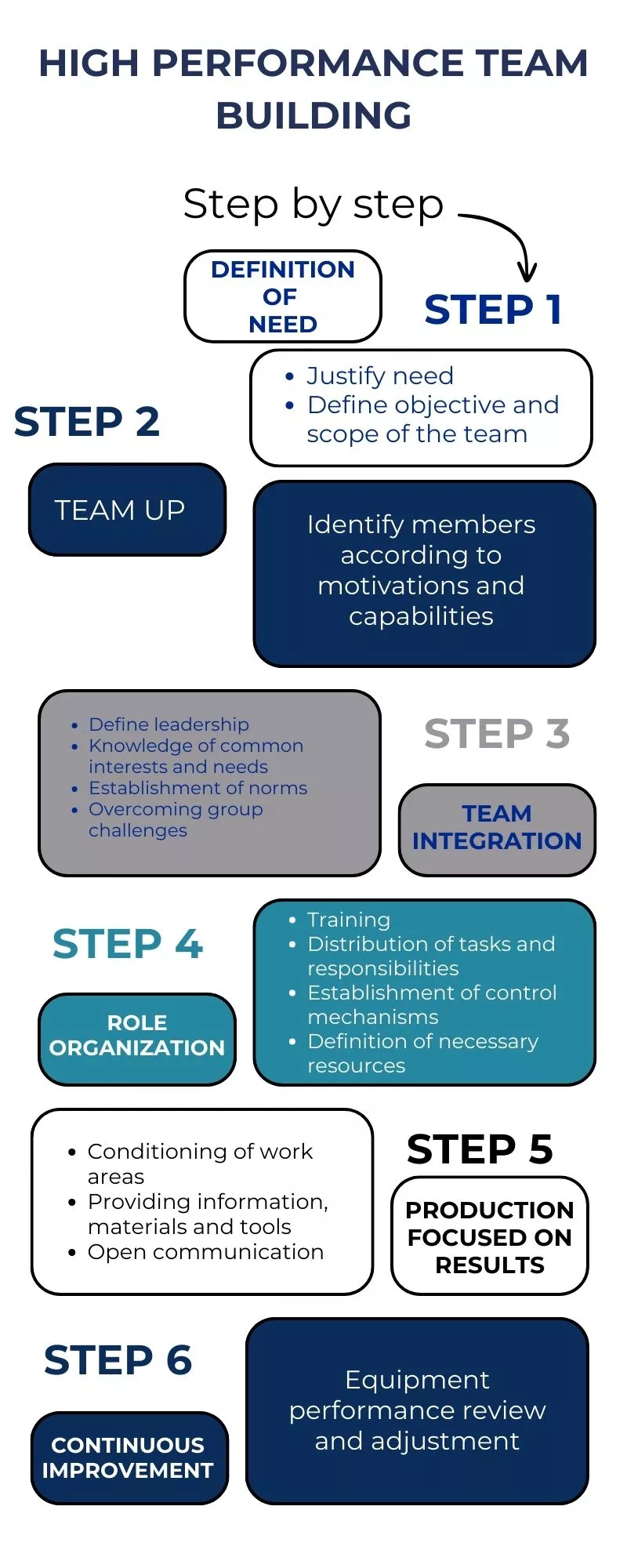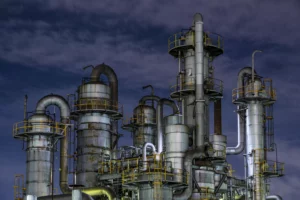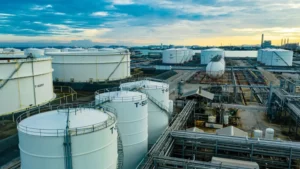Introduction
In today’s dynamic business environment, from a financial and market perspective, it is essential to achieve profitability and competitiveness, while from a process approach, high performance teams and the achievement of operational excellence are of great value. Against this backdrop, it is highly relevant to ask the question:
How can work be organized to achieve these purposes?
Work teams play a fundamental role, since their performance and contributions directly influence organizational results. The greatest effort and challenge for any organization lie in having dream teams distinguished by their productivity and innovation.
This article will address key strategies for fostering high performance teams (HPTs) and achieving operational excellence in the business environment, providing a comprehensive view of high performance teams and offering practical strategies for fostering them in the business environment. It will examine the characteristics of these teams, their composition and best practices for fostering their development.
Differences between group and Work team
Firstly, before outlining the specific characteristics of HPTs, it is important to differentiate between work groups, Work team, and high performance teams.
Work groups: These are formed by individuals with diverse skills and perspectives, who primarily collaborate in exchanging information and making decisions for the particular development of their role. Although each member contributes independently, the lack of a common purpose leads to a result that simply reflects the sum of individual efforts. These groups are often defined by the formal authority of the organization.
Work team: Are small groups of people with complementary skills and a shared purpose, characterized by cooperation, mutual trust, and smooth communication. Their effectiveness lies in the positive synergy they generate, driving constructive behaviors and promoting the achievement of collective goals.
According to Katzenbach and Smith (2000) cited by Uribe, et al. (2013), the differences between work group and work team include:
| Work group | Work team |
| Strong and clearly focused leader. Individual accountability. The group’s purpose aligns with the broader mission of the organization. Individual work products. Conducts efficient meetings. Measures effectiveness indirectly through its influence on others (such as the company’s financial performance). Discusses, decides, and delegates. | Shared leadership roles. Individual and mutual accountability. Specific team purpose achieved collectively. Collective work products. Encourages open discussion and active problem-solving meetings. Measures performance by evaluating collective work products. Discusses, decides, and works together. |
Regarding the presented characteristics, the evolution from “group” to “team” requires high levels of employee engagement, flexibility, adaptability, synergy, common focus among members, respect for individuality, team unity, complementarity, and defined purposes.
It is important to highlight that from a systemic perspective, organizations achieve objectives and results based on a combination of individual efforts. However, this does not imply that the team’s achievement is simply the sum of its members’ performances and competencies; multiple determining factors are involved.
What is a high performance teams?
Palomo (2012) defines a high-performance team as a group of talented individuals with complementary skills who collaborate towards a shared goal with a high level of dedication. These members interact under established norms and share emotions, creating a strong sense of camaraderie known as team spirit. As a result, the team achieves outstanding performance and obtains exceptional results.
High-performance teams optimize resource utilization, exhibit excellent productivity, and assign roles based on competencies and skills rather than authority position.
Importance of high performance teams
High performance teams are those that achieve results that exceed expectations and contribute significantly to the achievement of organizational objectives. The articulation and implementation of these teams contribute to collaborative work, efficient problem-solving, and rapid adaptation to changes in the environment.
In an increasingly competitive market, having high performance teams becomes a key differentiator for companies seeking to stay ahead, streamline their processes, and achieve operational excellence. According to Araneda, Cordero, and Landaeta (2008), high-performance teams enable greater goal achievement, lower losses, improved product or service quality, better coordination, a more relaxed work environment, exceed stakeholders’ expectations, and successfully turn visions into coherent action plans.
How is a High-Performance Team Formed?
It is proposed to follow the following sequence of steps to build high performance teams as outlined in Figure 1.

This figure provides a summary of the main activities, outlined as steps, for forming a high-performance team. This sequence highlights 6 steps consisting of:
- Definition of the need to form the HPT: Strategic vision in identifying the need for team formation is crucial, as well as defining the objectives pursued by the team and its scope of action.
- Team formation: Each team member brings their knowledge and skills, complementing and balancing each other. Training requires for team members should be identified during this phase.
- Team integration: Integration is necessary for the team to advance and develop in its functions. Interests, purposes, values, and common needs are identified within the team. Challenges for the group are also overcome during this phase.
- Role organization: In this phase, a detailed plan is developed to achieve the team’s objectives. Tasks and responsibilities are assigned to each member, considering their skills and competencies. Necessary resources are identified, and relevant training is conducted to ensure all members are prepared for their roles. Control mechanisms are established to evaluate performance and make adjustments as needed.
- Results-focused production: During this execution phase, workspaces are prepared, and there’s a focus on facilitating fluid information exchange among team members. Necessary materials and tools are provided to enable each member to perform their functions effectively, aiming to achieve established objectives.
- Continuous improvement: It involves a constant process of reviewing and adjusting practices and dynamics within the team to optimize performance. This includes identifying areas of opportunity, managing changes, and continuous monitoring.
To ensure success in forming and operating high performance teams, it is essential to closely follow these six detailed steps. Each of them represents an essential component in the process. Implementing these steps in shaping your teams and continually reviewing their progress ensures a path to success and operational excellence.
Likewise, continuous improvement can follow the quality principles of ISO 9001:2015, complementing the development of management leaders in high performance teams.
Strategies for developing high performance teams
The selection of strategies to implement will vary depending on the perspective from which the specific objectives are focused. Among the benefits that can be obtained are performance optimization and the achievement of operational excellence.
Here are some strategies presented below:
- Promote knowledge and innovation development among team members.
- Foster the internalization of organizational culture.
- Invest in training and development plans that strengthen both technical and soft skills.
- Establish compensation and incentive systems that encourage Employee Engagement and motivation.
- Provide technological tools that facilitate planning, organization, and control in the workplace.
- Set realistic and achievable goals that promote a sense of accomplishment and motivation in the team.
- Clearly define processes within the organization.
- Enhance leadership skills among team members.
- Encourage collaborative work, idea exchange, and joint problem-solving.
- Define responsibilities and their scope.
- Provide resources for task fulfillment.
- Foster a climate of trust and respect among team members.
- Encourage creativity and proactivity.
- Recognize and celebrate team successes.
- Analyze and share lessons learned, identify successes, and mistakes.
If you want to learn more about business strategies, I invite you to review the article “Turning Great Strategy into Great Performance” from Harvard Business Review (2005).
Conclusion
In today’s organizational environment, where operational excellence and performance are essential, high performance teams emerge as articulators and drivers of success. Through practical strategies and a sequence of fundamental steps, it is possible not only to form but also to enhance these teams, promoting innovation, collaboration, and goal achievement. By focusing on the development of high performance teams and continuous improvement, organizations can position themselves to stand out in a competitive market and achieve outstanding and sustainable long-term results.
References
- Araneda, K; Cordero, P; Landaeta, F; (2008). Model of High Performance Teams: An Experiential Proposal. Human Organizational Psychology. Vol.1, No.1, April, 25-48. https://www.researchgate.net/publication/341090027_Modelo_de_Equipos_de_Alto_Desempeno_Una_propuesta_experiencial
- Malpica, R., Rossell, R., & Hoffmann, I; (2014). High-Performance Work Teams. Labor Observatory Venezuelan Journal University of Carabobo, Vol. 7, No. 14, 69-83. https://www.redalyc.org/pdf/2190/219040849005.pdf
- Mankins, M; Steele, R; (2005). Turning Great Strategy into Great Performance. Harvard Business Review. https://hbr.org/2005/07/turning-great-strategy-into-great-performance
- Palomo, M. (2012). Leadership and Motivation of Work Teams. Mexico: ESIC Editorial.
- Uribe, A; Molina, J; Contreras, F; Barbosa, D; Espinosa, J; (2013). Leading High Performance Teams: A Great Challenge for Today’s Organizations. University & Company, vol. 15, no. 25, July-December, 53-71. https://revistas.urosario.edu.co/index.php/empresa/article/view/2873/2346.


























